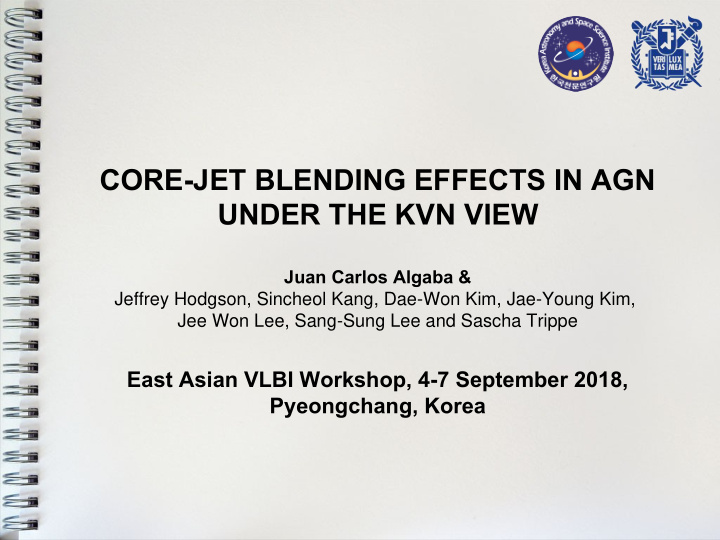



CORE-JET BLENDING EFFECTS IN AGN UNDER THE KVN VIEW Juan Carlos Algaba & Jeffrey Hodgson, Sincheol Kang, Dae-Won Kim, Jae-Young Kim, Jee Won Lee, Sang-Sung Lee and Sascha Trippe East Asian VLBI Workshop, 4-7 September 2018, Pyeongchang, Korea
Resolution and Blending Algaba Studies of AGN Structure: Typically core+jet When's the 'core' actually the core? Niinuma Core ( t =1 surface) VLBI core (beam...) In general, what we consider to be the core, is actually a blending of Kim, J.Y core+innermost jet, limited by resolution effects
Resolution and Blending Annoying blendings and how to fight them Integration of properties that are from core and jet Can affect the observables Core size / core shift Polarization Spectral index ...etc Possible Approaches Comparison with other maps with different resolutions Convolution with larger beam Monte Carlo simulations ...etc
Observations and Analysis Rioja+14 The case of the KVN KVN is a very powerful array Resolution is however still poor compared with e.g., VLBA (but see E-KVN talk by T. Jung) Previous Works Kim+18 Astrometry (Rioja+14) M87 spectral index (Kim+18) Results seem source-dependent May need a larger sample for statistics!
Observations and Analysis Our approach Comparison of KVN data with VLBA (Core flux, core size, brightness temperature) Multi-epoch (for repeatability) simultaneous data is difficult Not all frequencies can be followed up Need a multi-source sample for statistics Comparison of iMOGABA with BU 43 GHz light curves iMOGABA 22/43/86/129 GHz monthly monitoring with KVN VLBA-BU-BLAZAR Program 43 GHz monthly monitoring with VLBA
Observations and Analysis One script to check them all... ...and in the analysis bind them A script developed by Hodgson to modelfit iMOGABA sources
Observations and Analysis Some Sample Sources
Results and Discussion Inspecting the fractional variables VLBA/KVN Core Flux density Many sources, flux loss f S ~0.5 Some compact sources f S ~1 Variability in f S >1 Core Size VLBA ~8611km (MK-SC) KVN 476km (KT-KY) Expected factor f d ~0.1, but scatter is too large Other phenomena affecting
Results and Discussion Inspecting the fractional variables VLBA/KVN Brightness Temperature Size term is squared and its fractional ratio is much larger than that of the fluxes Tb severely limited by resolution (Expected higher Tb with higher resolutions, less blending effect. See e.g.,Pilipenko+18, Tb>10 13 )
Results and Discussion Are the properties of the source playing a role? Compactness Redshift Viewing angle
Results and Discussion Are the properties of the source playing a role? Compactness Redshift f d f d f d Viewing angle f S z viewing angle f T b f T b f T b f S z viewing angle No correlation found
Conclusions Core-jet blending effects need to be considered to characterize the source Comparison between KVN and VLBI suggest that blending includes phenomenology beyond pure array resolution Blending seems to be not related with properties of the source such as core dominance, redshift of viewing angle Can a common blending value be attributed to the array, independently of the source? Further source-by-source analysis and direct comparison
Thank You .
Recommend
More recommend